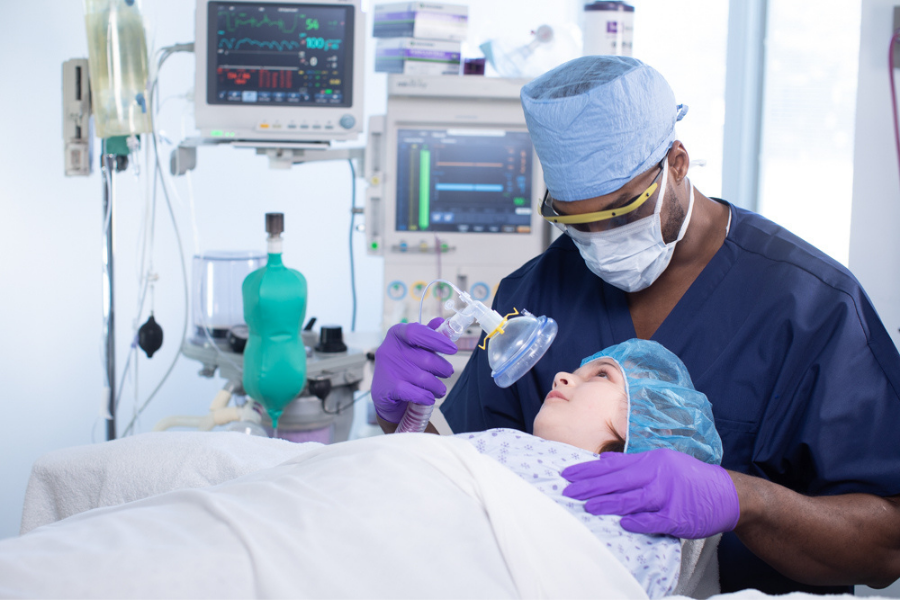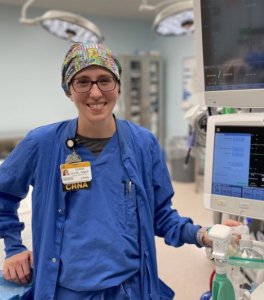
Diana Olive, DNAP, CRNA, a pediatric nurse anesthetist, is more than an anesthesia expert. Like all Certified Registered Nurse Anesthetists (CRNAs), she has a background as a critical care nurse. She said that background is key to CRNAs providing the best possible care for their patients – especially the youngest ones.
“Not only are CRNAs experts in anesthesia care, but we provide a personal touch to patient care thanks to our nursing background,” she said. “We understand what the patients and their families are going through and how anxious they are. We are able to provide calmness for children and assurance for parents before going back to the operating room. The patients and their parents really appreciate that.”

Olive spent two years as a progressive care nurse (a nurse who treats acutely ill patients in need of complex care, who need more monitoring than a medical-surgical floor but are not critical enough for an ICU), and three years as an ICU nurse before attending anesthesia school and becoming a CRNA. Having at least one year of critical care nursing experience is a requirement prior to applying to a nurse anesthesiology program.
When she was attending anesthesia school, she said working with kids made her nervous. “I realized after I graduated that I didn’t want to be scared of caring for children. I asked for more pediatric assignments and fell in love with taking care of kids. I found it was my true passion within anesthesia.”
She now works at University of Missouri Hospital in Columbia, Missouri, where she said she “takes care of every age from 25-week-old babies to the elderly,” but specializes in pediatrics.
“With pediatric patients, you have to be very attentive with the drug doses they’re receiving and with the second-by-second changes in their vitals. Having a critical care background, you’re tuned in to the very nuanced details of medication management. It translates well to caring for pediatric patients in the OR,” she said.
During pre-operative evaluations, Olive talks to parents about their child’s anesthesia answers their questions and eases their anxieties.
“We spend so much time in pre-op reassuring the parents and helping them understand what’s going to happen from an anesthesia point of view. We also try to prepare them for what to expect with their child in the recovery room,” she said.
In the OR, her job doesn’t end once she puts the child under anesthesia. She stays with the patient throughout the entire procedure, ensuring their comfort and safety.
“CRNAs are typically the ones sitting at the head of the bed, monitoring the patients’ vitals on a second-by-second basis,” she said.
She also provides the caring touch her patients need, both pre-operatively and in the operating room. “Because they’re so young and vulnerable, they need an extra loving set of hands to care for them through surgery.”
Olive said for older children who can understand what’s going on, it helps their anxiety to talk about their stuffed animals or toys they brought, families and lives in general. She recalled a four-year-old who was getting ear tubes placed for ear infections. He was clinging to his mom’s leg in the pre-op area, not wanting to leave her side.
“I crouched down on the floor and started talking with him about his blanket and slippers, which both had rocket ships on them. He eventually told me he really wanted to be an astronaut,” she said. “I told him we have lots of cool stuff in the OR and can pretend it’s a spaceship.”
She told him just like an astronaut has to put on a special helmet, he’d have a blue hat on and a bubblegum mask to breathe into, and a sticker on his finger so she could watch his heartbeat on her screen, “just like Mission Control watches the astronauts’ heartbeats.” She said they could even count down from 10 to blast off while he was breathing in the bubblegum mask.
“He held my hand and walked back to the OR with me, and he was so brave and almost made it to ‘blast off’ before falling asleep,” she said.
When Olive ran into the patient’s mom in the hallway after dropping him off in the post-anesthesia care unit, the mother expressed how grateful she was and gave Olive a hug.
“The parents are always so appreciative. Getting hugs from them is one of my favorite things,” she said.
She added, “When I was a bedside nurse, I learned how to connect with patients on a personal level. I feel like that helps me be willing to give the child and their family the extra time to really feel comfortable before we go back to the OR.”